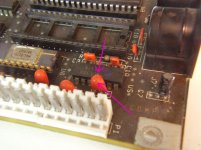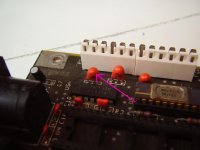Okay, so to finally wrap up what I did over the weekend:
I pulled that +12V cap. Why are they three-legged? It's just that bit harder to keep three solder spots hot at the same time; especially with a primitive soldering iron. Then I retested, but no joy. I actually (temporarily) replaced the +12V cap with that elco I showed earlier (above). Still no joy; no beeps from the speaker.
I then tested the voltages of the P8/P9 plugs while plugged in and powered on. They weren't proper across the board. Was the PSU bad despite the running fan? I didn't think so, because I'd earlier tested the PSU with just a floppy molex plugged into a drive (as a load) – the voltages had been normal everywhere then. So I unplugged the P8 plug from its P1 socket and tested power-up with just the P9 plug in its P2 socket. That caused the voltages to return to normal. I then returned to the excellent
-0° MDC guide that was also pointed out by Malc above (thank you), and I noted the P8 voltages: "Power good" pin: .01V; (next pin is omitted/key); +12V pin: .1V; -12V pin: 0V (and the other two are GND). Since the -12V pin read zero, I suspected something afoot there.
An aside: On my PSU, the colours differ from the ones depicted on -0°: I have power good as purple, key omitted, +12V green, -12V yellow, and -5V blue; GND and +5V are the same: black and red, respectively. Maybe that info is a worthy addition to -0°? Modem7?
I now took a closer look at the -12V trace's cap. It hadn't blown up, but if you looked closely, you could kind of see what seemed to be a little bulge, plus a subtle minor dark spot:
So since I already knew that the -12V trace seemed to just lead to the extension card slot (
position B7, as per above and
per TechRef D-21), and since that contact has no trace on my potentially sacrificial CGA-compatible card, I decided to just pull that -12V too and retest.
Removing the -12V tantalum cap turned out to be more difficult than pulling a ****ing tooth, and I ripped out one of the leads, but I got everything out in the end. When I retested, the voltages had returned to normal.
But alas! Still no noise from the speaker, not even when I soldered and wired up another speaker, just in case of a defect of the existing one. (Does polarity really matter with speakers? Because I'm not sure the polarity is correct
here.) Also, no picture when I tried a test with the CGA-compatible an the 5153, though the monitor did darken from the blank white OFF state to a blank grey screen on 5150 switch-on.
To be thorough, I determined
what all the bigger caps were wired to (pre-cap removal and pre-relay cleanup picture). Two of the +5V caps look different. They also have little K's on them. Does that have any significance? (Prolly not.)
Despite the fact that the voltages are all nominal, could the +5V caps still be at fault?
Could the relay still be at fault?
I also had the 8087 present DIP switch wrong for an attempt (because of inconsistent documentation) – could this have caused some lasting damage?
Is there a chance that washing the board as recommended earlier would actually improve its state electronics-wise?
I'm actually thinking now that maybe it was entirely wrong to blame the relay; maybe it just
looked bad, but wasn't really. Maybe it was those two 12V tantalum caps – plus some other faults yet to be determined.
I took it from the
-0° MDC guide that the heat now should be on the DRAMs, and specifically on the DRAMs in bank 0. What's rather problematic though is that:
- I don't actually have any compatible DRAMs to replace those 8KB DRAMs with permanently (some old DRAMs I've still got are incompatible 256KB ones [I take it it's impossible to use those as piggibackers or replacements in any way?], and even the many DRAMs I've got on an AST RAMpage! RAM-card are [presumably incompatible?] 32KB ones) , and
- even temporarily using some of the DRAMs from e.g. bank 3 on the 5150 mainboard itself for piggyback-testing of its bank 0 might be a problem, because -0° tells me there are BIOS bugs that actually make the 5150 want all its banks to be fully populated (though DRAM sizes can still vary for varying amounts of RAM). Another problem is that
- I don't have an EPROM writer, so do use the SuperSoft/Landmark diagnostic ROM troubleshooting method the MDC guide recommends, I'd have to buy one first – or buy the actual SuperSoft ROM off someone.
It was at this point that I gave in and ordered a relatively (but still reasonably) expensive replacement board off eBay. Clearly troubleshooting and replacing faulty DRAMs is going to be difficult, and I don't even know for a fact that that's now the problem, or the only problem, and once I've ordered a ROM and DRAMs (that I also have to find first), I'll have spent a lot of time and some money, and there's a real danger that I'll run out of steam before I get that 5150 running again, so since I'm already ordering various components, let's make hay while the sun is shining, grit my teeth, bite the bullet and swallow the "bitter bill" [sic]. ;-)
However, though this spending splurge will hopefully get my 5150 restoration back on track, my ordering that replacement board does not mean that I've entirely given up on the old one yet – because it also occurs to me that between a bunch of components I got (e.g. a spare PSU and keyboard from a 5155, etc.), with that board, I'm a monitor shy of a second PC. That second PC would be a bit of a Frankenputer; not in its original case, and with odd clone cards, etc, but still. The prospect is enough reason not to give up on Þe olde maine boarde just yet.
If I read that -0° page on those BIOS bugs correctly, bug 1 shouldn't prevent me from booting to BASIC at least, correct?
Also, does
what it says under "Symptoms" for bug 2 mean that I could maybe remove all the DRAMs from bank 3, set SW1 and SW2 for one bank only, and maybe also not see that 201 error? Is that error a halting one – i.e. will it prevent me from booting to BASIC at least? Given encouraging answers to that one, I'll probably try piggy-backing around and see if I can get something more than no beeps and no picture.
If that doesn't work, then in time, I may order that SuperSoft ROM off someone, but that's probably not going to be soon. I hope to get the non-Frankenputer 5150 up and running with the replacement board before then, and I hope I'll be able to report back how I'm getting on, and then return to case cleaning and restoration as well.
Then you very much for your help, everybody, and if you can still help even more by answering any of the above questions, please do!



